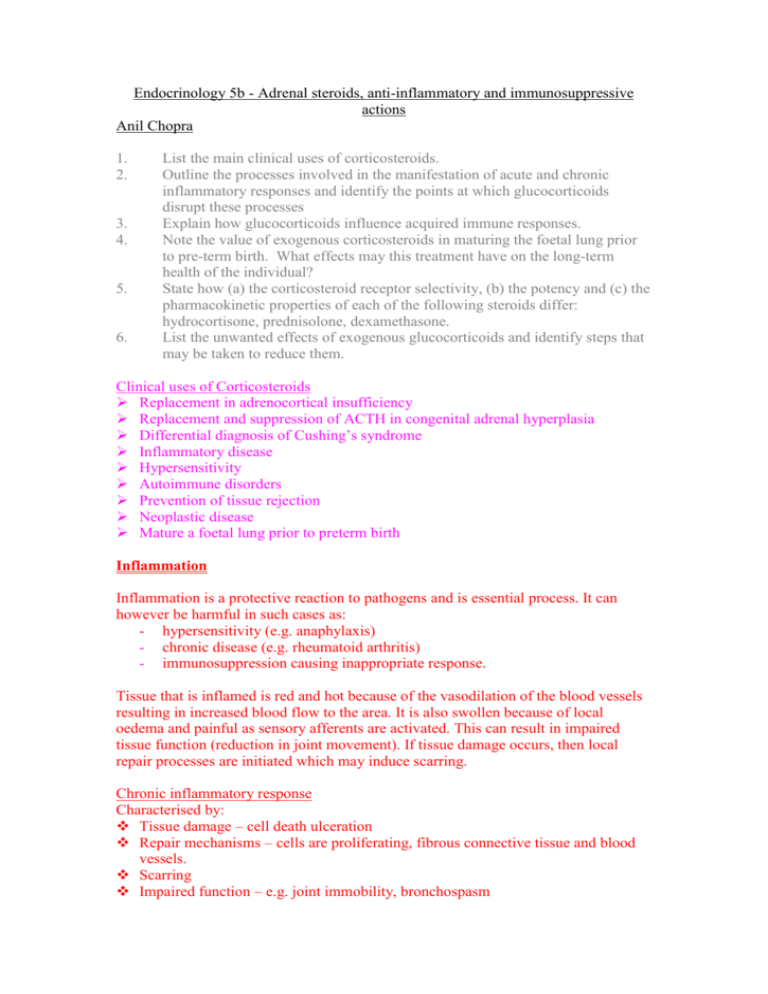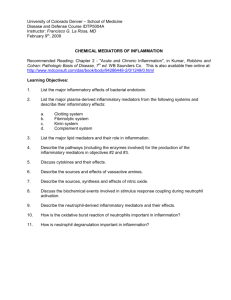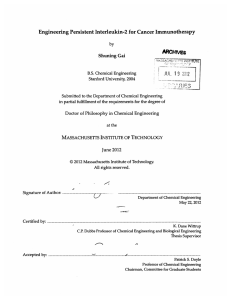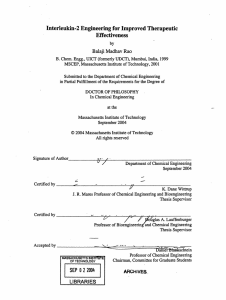Endocrinology 5b – Adrenal steroids, anti-inflammatory and
advertisement

Endocrinology 5b - Adrenal steroids, anti-inflammatory and immunosuppressive actions Anil Chopra 1. 2. 3. 4. 5. 6. List the main clinical uses of corticosteroids. Outline the processes involved in the manifestation of acute and chronic inflammatory responses and identify the points at which glucocorticoids disrupt these processes Explain how glucocorticoids influence acquired immune responses. Note the value of exogenous corticosteroids in maturing the foetal lung prior to pre-term birth. What effects may this treatment have on the long-term health of the individual? State how (a) the corticosteroid receptor selectivity, (b) the potency and (c) the pharmacokinetic properties of each of the following steroids differ: hydrocortisone, prednisolone, dexamethasone. List the unwanted effects of exogenous glucocorticoids and identify steps that may be taken to reduce them. Clinical uses of Corticosteroids Replacement in adrenocortical insufficiency Replacement and suppression of ACTH in congenital adrenal hyperplasia Differential diagnosis of Cushing’s syndrome Inflammatory disease Hypersensitivity Autoimmune disorders Prevention of tissue rejection Neoplastic disease Mature a foetal lung prior to preterm birth Inflammation Inflammation is a protective reaction to pathogens and is essential process. It can however be harmful in such cases as: - hypersensitivity (e.g. anaphylaxis) - chronic disease (e.g. rheumatoid arthritis) - immunosuppression causing inappropriate response. Tissue that is inflamed is red and hot because of the vasodilation of the blood vessels resulting in increased blood flow to the area. It is also swollen because of local oedema and painful as sensory afferents are activated. This can result in impaired tissue function (reduction in joint movement). If tissue damage occurs, then local repair processes are initiated which may induce scarring. Chronic inflammatory response Characterised by: Tissue damage – cell death ulceration Repair mechanisms – cells are proliferating, fibrous connective tissue and blood vessels. Scarring Impaired function – e.g. joint immobility, bronchospasm Caused by: Innate response (non immunological) This comprises vascular and cellular events triggered by pro-inflammatory mediators such as complement in blood plasma, histamine, cytokines, nitric oxide e.t.c. from invading cells. It can be modulated by ant-inflammatory substances. Acquired Specific responses (immunological) These are initiated by antigens released by invading organisms, or other exogenous substances/proteins resulting in a hypersensitivity reaction. Hypersensitivity reactions to exogenous substances – underlies allergic disease Hypersensitivity reaction to endogenous substances, normally innocuos – underlies autoimmune disease Vascular events of inflammation: Vasodilation and increased blood flow Increased capillary permeability and leakage Activation of enzyme cascades in the exudate with the consequent release of mediators (Bradykinin and complement) which: Cause pain Induce further increases in vascular permeability and in local mediator release (e.g. histamine) Acts as spasmogens Are chemeotactic and activate phagocytic cells Causes bacterial lysis Cellular events of inflammation: Local cells: o Mast cells – release pro-inflammatory mediators e.g. histamine, eicosanoids and cytokines in response to complement and antigen o Tissue macrophages – release cytokines, chemoattractants and other mediators, engulf debris, dead cells and micro-organisms o Endothelial cells – release vasodilators and other mediators and contribute to angiogenesis o Fibroblasts – produce matrix proteins and lay down fibrous tissue in areas of healing and chronic inflammation Cells that migrate from the blood stream to tissues: o Ploymorphonuclear leukocytes – neutrophils and then eosinophils are recruited by chemoattractants – kill invading pathogens by releasing toxic products can also damage host if activated inappropriately o Monocytes – enter at later stages and are transformed into and function as tissue macrophages o Platelets – release eicosanoids, free radicals, also contribute to tissue repair processes Anti-Inflammatory Drugs There are 2 types Non-steroidal – e.g. aspirin (see pharmacology) Steroidal – glucocorticoids Names Cortisol (hydrocortisone) - mineralocorticoid activity at high doses Prednisolone - weak mineralocorticoid activity Dexamethasone - no mineralocorticoid activity Usage – Asthma, by inhalation or systemically in severe cases – Inflammatory conditions of the skin, nasal mucosa, ear, eye, joints (local admin where possible) – Autoimmune/inflammatory disease, e.g. rheumatoid arthritis – Other autoimmune disease, e.g. myasthenia gravis – To prevent rejection following organ or bone marrow transplants – In combination with cytotoxic drugs in specific malignancies, e.g. acute lymphocytic leukaemia.To reduce cerebral oedema in patients with brain tumours. – As a component of anti-emetic treatment with chemotherapy – To elevate mood in terminally ill subjects – To mature the foetal lung for pre-term birth in pregnancy by increasing surfactant cell maturation Mode of Action Major steps in the initiation of an immune response: Antigen is presented by antigen presenting cell to a naïve CD4 T-helper cell which respond by expressing IL-2 receptors and IL-2 proteins IL-2 acts as an autocrine agent causing proliferation of the cells and the subsequent generation of a clone of activated T-cells (Th0) Th0 cells differentiate to Th1 or Th2 subsets Th1 cells produce IL-2 and IFNγ which cause cells to proliferate and differentiate into CD8 t-cells which affect cell mediated response Th2 cells produce IL-4 which acts on B cells – causing them to proliferate and generate anti-bodies which mediate humoral immune responses Glucocorticoids inhibit the early and late stages of inflammation by modifying vascular and cellular events. They: inhibit vasodilation stop fluid from the circulation leaking into damaged area reduce the influx and activation of polymorphic neutrophils reduce recruitment and activation of mononuclear cells inhibits angiogenesis (blood vessel formation). blocks clonal proliferation of T-cells inhibits fibroblast function (extracellular matrix is not maintained) The glucocorticoids enter cells and act on intracellular glucocorticoid receptors which alter gene function essentially inhibiting the production of: – Pro-inflammatory cytokines (e.g. IL-2) – Enzymes required for the biosynthesis of pro-inflammatory mediators (e.g. COX-2, NOS-2) – Anti-inflammatory proteins such as histamine. – Adhesion proteins – Complement – Nitric oxide – Matrix proteins such as collagen & glycosaminoglycans – Eicosanoids (prostanoids, leukotrienes and PAF) They activate the production of – Enzymes that degrade matrix proteins, e.g. collagenase – Anti-inflammatory proteins, e.g. annexin 1 Side effects and Pharmacokinetics K+ loss Na+, Cl- and H20 retention Hypertension Muscle wasting Centripetal obesity, moon face, buffalo hump Hyperglycaemia steroid diabetes Increased appetite Osteoporosis Increased risk of infection Poor wound healing, easy bruising Thin skin Impaired growth Disorders of menstruation Suppression of the HPA axis Mood changes Increased risk of cataracts and peptic ulcers Suspected action on the foetus/neonate that predispose to diseases in adulthood. Pharmacokinetics: » Administration: - all effective orally. Hydrocortisone, prednisolone and dexamethasone may also by given IV or IM » Distribution: o Hydrocortisone – 90-95% bound to corticosteroid binding globulin (CBG) in blood and to albumin. Fress steroid penetrates all compartments of the body o Prednisolone – binds to CBG o Dexamethasone & fludrocortisone – bind weakly to albumin only » Metabolism: - Hepatic. The principal steps are the reduction f the A ring, conjugation and excretion in bile and urine » Hydrocortisone & fludrocortisone – plasma half life = 1.5hrs, duration of action = 8hrs » Prednisolone – plasma half life = 1.5 hrs, duration of action = 12hrs » Dexamethasone – plasma half life – 1.5hrs, duration of action is more than 36hrs due to slow metabolism How to minimise unwanted effects: Administer locally where possible Use minimum effective dose Use GR-selective steroids Use ACTH in children to reduce growth suppression Recommend patients carry a steroid card Withdraw steroids early – but do not suddenly stop them











